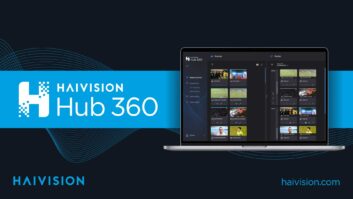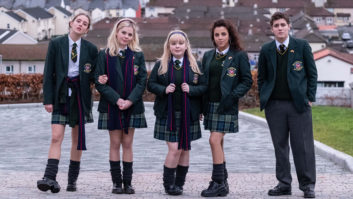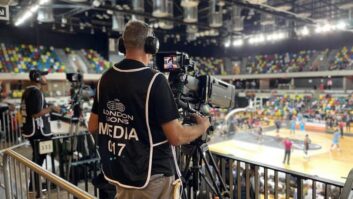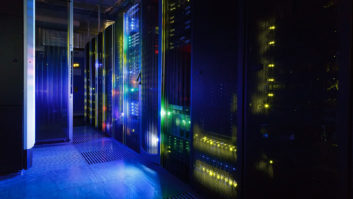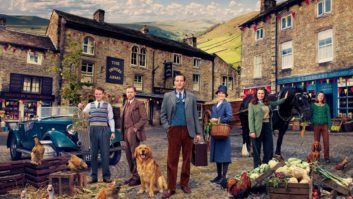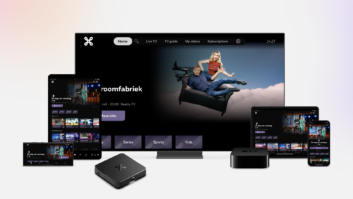By David Fox
Timeline TV is “an OB company that’s moved into facilities,” according to its Commercial Director Stephen Davis (pictured right). It has recently built a new multi-channel playout centre for Racing UK, which went on air on 28 February at Ealing Studios in west London, and will open its third post facility (at MediaCity UK) in April.
Since its establishment in 2006, Timeline has expanded from providing tapeless server systems for outside broadcasts to flyaway production units, RF and comms, as well as developing post houses in central and west London.
It was originally set up to provide EVS systems for sports and has “delivered the biggest EVS solutions outside of EVS.” It is now taking the tapeless workflow expertise it has developed in sport and applying it to other forms of programming, including news events and documentaries.
“The tapeless workflow is at the core of what we deliver, but we’ve grown the business either side of it to offer full production facilities,” says Davis.
“We found that people didn’t know what to do with the media” that accumulates in covering events, so it offered services to synchronise media and edits. This led into working on the BBC’s Formula 1 coverage, for which Timeline TV now holds 2,500 hours of archive. It has a SAN in Ealing for the pre-show edits, then takes any changes on a drive to the OB, where the editors can immediately pick up again and finish editing, adding extra material from the track, and can then finish any remaining pieces back in Ealing afterwards. It has fibre lines to the BBC for delivery.
It also worked on the Cricket World Cup, for which it built the facilities to suit the six-week event, with 37 live network programmes broadcast on BBC2 from Ealing.
Timeline TV’s biggest server system, using a 50-seat IPDirector set up, was for the 2011 Wimbledon Tennis Championships, providing recording on 16 HD EVS XT2s for every match for the BBC and IMG (for the World Feed and archive), with producers logging the action on every court. The logs combined the producer’s subjective classification with live statistical information from the on-court scoring system.
The company essentially provided an International Broadcast Centre at Wimbledon, selling IPD seats on the system to other broadcasters (it had 11 of these in 2011), all of whom also had access to a fully logged archive from 2007 (when it started working on Wimbledon) to 2010. All media is backed up to removable storage for redundancy and, when the tournament is over, forms Wimbledon’s permanent digital archive.
Timeline provides a similar set up for the Australian and French Open Tennis Championships, and also for news events, such as the UK’s three big party political conferences (held each Autumn), where it supplied facilities for Britain’s three main news broadcasters (BBC, ITN and Sky News).
All of the media goes into the central system and is logged and made available to all three news organisations, who responded positively to its question: ‘We have this system, why not collaborate?’ Timeline looks after the complete workflow, from before the event through post to archive.
This system has been operating since 2007, and in 2011 it had four HD XT2s recording all the action in HD, with several low-res servers recording proxy copies. More than 30 IPDirector terminals were distributed among the broadcasters for instant access to any story. Each broadcaster also had their own ingest terminals, with security settings guaranteeing exclusive access to any content they didn’t want to share while making it simple to share any material they did.
The IPDirector system integrates with both Avid and Final Cut Pro suites and Timeline provided 15 editing suites ranging from Avid laptops to a full shared Xsan system. The main speeches are logged by journalists to allow all producers to search and quickly find clips and send them to their edit suites.
End-to-end efficiency
“It’s been difficult for the producers to specify what they want as the technology has changed. They are familiar with tape, but not with tapeless. Their problem isn’t just the technology, but the workflow,” says Commercial Director Stephen Davis. Timeline aims to look after the complete end-to-end workflow, becoming involved in the production, so that it can make it happen as efficiently as possible.
It has applied that model to more general programming, such as Garden Productions’ Seven Dwarves (a 7 x 60mins documentary series for Channel 4, which was transmitted last Autumn and involved lots of mini cameras observing the dwarves’ lives). “We’re applying the basic principles of sports production to general programming that needs to be high quality and fast turnaround.”
It also worked on the makeover show, House of Grazia, for Sky Living last year. “Sports has been years ahead in tapeless,” and although there are some differences between sports and general programming, “the core technology is the same,” says Davis.
“We’re used to higher stress levels in sports production, and we’re able to bring the same level of energy,” along with expertise in server-based production.
Drama may not seem an obvious next step, but it is working with ITV’s award-winning period drama Downton Abbey (produced by Carnival Films) as a joint venture with Ealing, which provides the studios while Timeline does the post production.
Davis praises the flexibility offered by Ealing Studios, which allows Timeline to rapidly increase its space as needed. “Our aim is to keep competitive, and our relationship with Ealing enables us to do that.”
Its own facilities are also built to be flexible, so a room can quickly convert from an editing suite to a live commentary area. “We’re very solution-focused. We can adapt very quickly,” he adds.
“The reduction in price of broadcast equipment allowed us to step into this market, providing the same level of engineering still, but reducing the cost of the equipment.” This is how it was able to move into the flyaway market, for example, where it has worked on such events as the Volvo Ocean Race.
It is also working on long-form outside broadcasts for Sky, where it provides the technology and staff.
“Long-form OBs have more media management issues. We are using our server trailer for Sky’s darts coverage. It contains near-line RAID storage for archive (70TB), Avid Unity Interplay, and offers EVS integration with whichever OB truck is in use that day,” he explains.
“It allows Sky some consistency over several OB companies and means the OB companies don’t have to worry about operating the archive.” Timeline provided a smaller server trailer for the party conferences, and has used them for Ryder Cup golf (linking into temporary edit suites) and concerts (where it was also used to produce limited news feeds).
It also does consultancy for broadcasters and other facilities on tapeless, such as Sky News, The London Studios, IMG Mediahouse and Input Media. “Technology gets more complicated by the year and it’s the technical knowledge that wins the contracts,” he says.
Racing home
Timeline won a seven-year contract with Racing UK last year to provide a new playout and production centre, which has just opened. “Racing UK is on a whole different level,” says Davis.
It is using a new building at Ealing to produce the Racing UK channel, on Sky, and Turf TV, which goes to 95% of betting shops in the UK. Each has its own look. Racing UK has presenters, while Turf TV is more informational, including virtual racing and results from other sports. It also produces GBI Racing, an international channel for British and Irish racing, which is a combination of Racing UK and At The Races. There are three versions: for Australia, Hong Kong, and the rest of the world.
To connect to 30 racecourses around the country, the Master Control Room uses BT’s JPEG2000 MPLS (Multi Protocol Label Switching) network, which was chosen to minimise picture latency, an important consideration for betting. “For each racecourse we get back an international feed, a presentation feed and a reserve feed,” explains Dan McDonnell (pictured), Timeline’s managing director. “We can get six simultaneous racecourses – 18 incoming lines – at once.” There are also back ups for each of the 18 lines, with two diverse paths all the way from the racecourses to Ealing.
BT provides all the ISDN codecs in a rack, and Timeline has written its own remote control software to dial out from the MCR, so that everything can be controlled from there.
The building has a three-camera studio (800sq feet/75sq metres) for Racing UK that can have two sets (for day and eventing shows), and a single-camera talking heads studio for Turf TV. Both have Hitachi DK-H100 2/3-inch 3-CCD HD box cameras, with Canon lenses, on Shotoku robotic heads (but not robotic pedestals as all they require is to be repositioned as production moves from one set to the other).
With the Shotoku system “we can have all pre-programmed sequences and just hit the touchscreen. Lighting and cameras are all controlled by one person,” in the MCR, says McDonnell. The MCR also has an engineer and an ingest operator (which includes taking in material from crews shooting news stories, press conferences and features).
“The unique thing about this flexibility is the tapeless system,” which uses IPDirector. It takes a data feed from the Press Association, with details of runners, riders, race start times, timecode from the events, the results and what happened to each horse. This populates the IPDirector database and producers can use the information to select low-res clips and send any shots they select to the edit or put it on air, or send graphics to be prepared.
All the media is backed up overnight to LTO-5 tape for archive, with 120 tapes kept in the LTO robot. There is also a copy of every tape off site for disaster recovery.
It has a 250TB central SAN for long-term access to low-resolution media, while high-resolution media will either be on the SAN (if it is recent) or LTO-5. “The key thing is the producer can look at all the media instantly, search the archive, and get bits immediately off the LTO robot, or loaded in from older LTO tapes.”
The vision galleries are fitted with Grass Valley Karrera switchers (a 3M/E version for RUK and a 2M/E model for TTV) – the first in the UK. These are pre-production models to get the channels on air and will be replaced with production models once they start shipping.
One of the reasons McDonnell likes the Karrera is that it has dual-channel K2 Solo clip storage, which can be used to replay wipes, picture-in-picture and run animated backgrounds, “like having another VT source”.
The galleries also have EVS LSM XT3 controllers, fully integrated with the servers. “This is at the heart of the system,” he says. “Everything goes through the server before going to the SAN.” It has 12 ingest channels, and three servers (two for Racing UK, one for Turf TV – but all can share clips).
Graphics are created on Chyron’s HyperX systems, two each for the two main channels, with live betting odds and results taken from the PA data feed, “so there is no data entry required by the operators.” There are two operators per main channel, who also work for the edit suites.
The build began in October, and the building went on air on 28 February. Megahertz Broadcast did the system integration and installation, as McDonnell had worked with them before and knew they could deliver on time, while Studio Schemes did the build (floating studios, air conditioning, mains wiring and everything building related).
It uses an Evertz EQX router, with two complete crosspoint paths for redundancy. “If one path fails it can seamlessly recover. It is also 3G compliant for future use,” he says. “We particularly like the control system. It is fully programmable and every button can do multiple things. This is particularly important as everyone wants to find all the sources very quickly.”
The choice of matrix meant it made sense to envelop it with Evertz infrastructure, such as multiviewers, DAs, audio DAs, embedders/de-embedders, and master clock.
The talkback system is a Riedel Artist 128-port frame. For redundancy, the machine room also connects with Timeline’s existing MCR in another building at Ealing using Riedel MediorNet, which can carry multiple HD video signals, audio, reference and network signals, and talkback matrix panels, between the buildings using a single fibre (there are main and backup fibres linking the sites).
“It’s an amazingly versatile box. You can almost put any signal into it – MADI, AES and analogue audio, analogue video, HD video. It’s also taking a feed from the talkback matrix, so you can have full communication between the MCRs,” integrating them both, he says.
If the Racing UK building had to be evacuated, this would allow it continue on air. “We can remotely switch the Evertz and take on the talkback system, so everything in this building can be controlled from the other building, and vice versa,” explains McDonnell.
There are three identical gallery suites for the three GBI channels, each with a Ross Carbonite 1M/E mixer, which also generates multiviewers, an EVS LSM for replays, and a graphics console for automated graphics. Timeline has also developed some custom hardware and software so that when the director goes between sources, the audio follows.
Racing UK has chosen Final Cut Pro 7 for editing, but will migrate to X eventually, for its three edit suites. Timeline uses both FCP and Avid equally, depending on client choice. For Downton Abbey, for example, it uses Avid.
In April, Timeline is also opening a new facility at the MediaCity UK site in Salford (Manchester), beside BBC North and the BBC Sport department. It will have six edit suites (switchable between Avid and Final Cut), an Autodesk Smoke finishing suite and a ProTools audio suite.
“We do a lot of BBC work currently, and BBC Sport has moved to Manchester and encouraged independent facilities to open up there,” says McDonnell. It will also have an EVS operation there, for live ingest and playout, with IPDirector systems and two XT3 servers.
